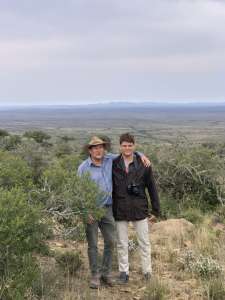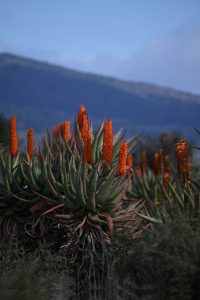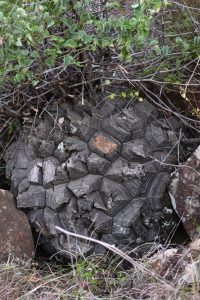The Khoisan, the first people of the Nama Karoo, believe that the earth is a gift from Tsui//Goab or the Supreme Being to all people. If we nurture the land, they say that it will take care of us now and for generations to follow. As I prepared for my trip to take photos of the endangered succulents and plants of the Nama Karoo, this idea was at the front of my mind.
In June and July, I conducted independent research on the plant life in the Nama Karoo and emailed back and forth with the horticulturist James Fisk. He and I arrived in this remote semi-desert biome in mid-August with a list of plants I hoped to track down and photograph during my week visiting family. It was the end of the South African winter, and I was greeted by a sea of blooming Aloe ferox and coral Aloe Striata at every turn. In fact, in the days that followed I was struck by how much this arid and desert-like paradise, teeming with unique plant life, reminded me of pristine ocean coral reefs. The Nama Karoo terrain is filled with unusual plants, many with powerful medicinal qualities. James and I walked for hours on end alone in the mountains and in the valleys, in search of these plants, some in plain sight, and others well-camouflaged and hidden by the landscape. Taking photos in this environment was a dusty and challenging endeavor. To capture the right shot, I found myself lying flat on the ground or twisting my head and body to manage the light and surrounding plants. My camera lenses required frequent cleaning from the dirt, and my Nikon D850 froze up more often than expected, making it impossible to focus, and requiring me to use my iPhone camera as a back-up. Despite these challenges, we managed to achieve our mission. We discovered a large rocky slope covered with about 30 well-disguised and difficult to find Dioscorea Elephantipes plant, the “elephant’s foot”, known for its heart shaped leaves and its unusual conical grey ridged trunk resembling elephant skin. They are frequent targets for plant poachers looking to sell them to collectors in the lucrative overseas rare plant market. Sprinkled among a series of rocky beds we also came across the Sutherlandia frutescens also known as the “cancer bush,” a beautiful red flowered plant dangling with seaweed like pods which can help stop the progression of HIV and cancer. We sampled the bright green-leafed Portulacaria Afra or “spekboom” shrubs which dot the landscape. Indigenous to the Karoo, this miracle plant is not only an excellent food source (the leaves tasted like sour grapes to me) but a carbon removing savior. It can absorb from four to ten tons of carbon per hectare per year, more than 10 times the amount that a tropical rainforest tree can absorb from the atmosphere. Through my lens I was also able to observe the impact of stock farming on several distant mountains. The demarcation line between the fenced in, untouched land, and the grazed land was pronounced. The grazed land could take generations to return to its natural state. Similarly, I learned that once a road is graded or a path is created with vehicle treads here, it will last for generations. Unless these trails are carefully managed, they create permanent watercourses which over time can lead to irreversible soil erosion. To the informed eye, the human impact on this fragile semi-desert environment is apparent.
It was our discovery of the Euphorbia Obesa or the “baseball plant” however, which left the greatest mark on me. This succulent, which resembles a sea urchin, is on the South African National Biodiversity Institute’s (SANBI) Red List of “endangered” plants and requires a national and international permit to pick, grow and sell. The plant can only be found growing in the wild, hidden by dwarf shrubs, in one unmarked shale-covered field in the Nama Karoo. I felt fortunate, and at the same time, sad to know that it was likely that the 50 some odd plants we found were probably all that was left of this endangered plant species growing in its natural habitat in the world. Discovered in the Nama Karoo in 1897 by botanist Peter Macowan, the Euphorbia Obesa was first sent to the Kew Royal Botanical Gardens in the U.K. It quickly became highly coveted by plant collectors in Europe spurring a plant rush. Once abundant in the area, the Euphorbia Obesa became scarcer and scarcer. Sadly, its dwindling numbers only served to increase its desirability, most recently among Asian plant collectors. The locals each have a story about the amoral train conductor and the schoolteacher who paid children to collect Euphorbia Obesa from the fields so that they could sell them at high prices to passing English, German, and Dutch tourists on the train line. Today, plant poachers supported by the same international crime syndicates trading in elephant tusks and rhino horns, pay local farm workers to collect these plants at night. As I was taking photos, James and I did our best to be inconspicuous, and we agreed to never share the exact location of these specimens with anyone. Nevertheless, the Euphorbia Obesa’s story is a disheartening example of the irreparable harm that humans can have on the environment. If it could happen to the Euphorbia Obesa, it could also happen to any of the plants in this unique and important semi-desert biome. There are plants in the Nama Karoo that can heal people and make a dent on climate change. Like the Khoisan people, I think we should do all that we can to preserve and protect them.
I’m now back home and have started going through the hundreds of photographs I took of these plants in their natural habitats. I’ve included a few here and am looking forward to sharing more on campus, online, and with South African environmental organizations like the World Wildlife Fund South Africa to help draw awareness to the issue of succulent plant poaching, and to highlight how important it is that we preserve these vulnerable and critical ecosystems.
Thank you to James Fisk for his mentorship and to the Earle and Mendillo families for their grant/support of my project and for this inspiring experience.
-Alex ’24






